Small Aircraft Carriers: RAND Report Won’t Convince McCain
Posted on
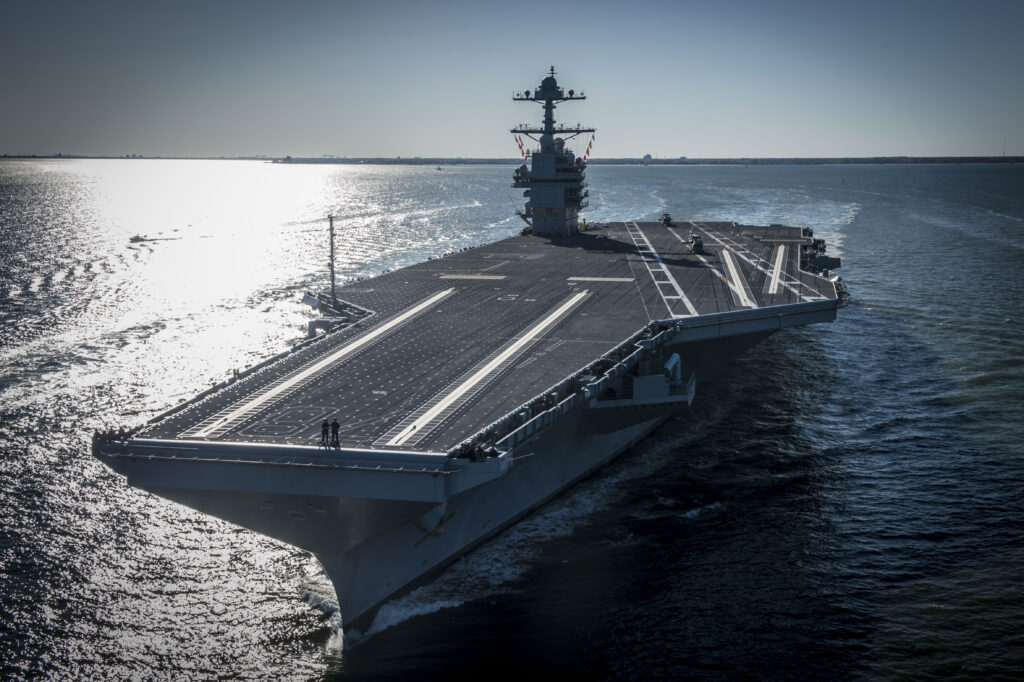
USS Gerald Ford
WASHINGTON: The fleet needs smaller, cheaper aircraft carriers than the badly over budget, behind schedule Gerald Ford, ex-Navy pilot John McCain has long argued. No way, “Bigger Aircraft Carriers Are Better,” declares a recent National Interest article – widely publicized by the carrier industry’s advocacy group, ACIBC – citing a study that RAND did for the Navy. But McCain is unlikely to be convinced, and RAND actually thought at least one kind of smaller carrier was worth considering.

John McCain
The RAND report doesn’t refute McCain’s argument, a Hill staffer told me, because it doesn’t really answer the question the Senate Armed Services chairman was asking. “They looked at them (the alternative designs) against the mission set the Ford does in the most stressing scenario” – a major war against a sophisticated adversary like China – “and not surprisingly found out they’re not as good,” the staffer said. “They punted on the whole spectrum of other things aircraft carriers can do where a Ford is overkill and where a smaller carrier might be more suitable.”
RAND also makes only passing mention of one of McCain’s central ideas, that “The Navy should also pursue a new ‘high/low mix’ in its aircraft carrier fleet,” to quote his white paper, Restoring American Power. “Traditional nuclear-powered supercarriers remain necessary to deter and defeat near-peer competitors, but other day-to-day missions, such as power projection, sea lane control, close air support, or counterterrorism, can be achieved with a smaller, lower cost, conventionally powered aircraft carrier.”
RAND did say such a mix of larger and smaller flattops working together, each taking on different missions, “might lower risk somewhat” and make it more “manageable. But the thinktank didn’t study it in depth as a long-term solution.

A notional future naval battle (CSBA graphic)
So, the RAND report may not meet the legal mandate. In the final language passed by the House and Senate, the National Defense Authorization Act for 2016, Section 128(d), orders the Navy to report to Congress on alternative carrier designs
- “for a range of operational scenarios”;
- “that would replace or supplement the CVN–78 class aircraft carrier” (emphasis ours); and
- “ranging from less than 20,000 tons to greater than 100,000 tons.”
However, the RAND report
- only analyzed performance in “the most stressing scenario,”
- looked at a “lower-cost carrier replacement” for the Ford that would “over time, define the carrier force”; and
- only looked at sizes from 20,000 to 100,000 tons, nothing smaller or larger.
While McCain advocates smaller carriers, the NDAA also asks the Navy to study something bigger than the current supercarriers, examining both ends of the spectrum – which RAND didn’t do.
Even if you set aside all of the criticisms above, however, “bigger is better” still isn’t a fair summary of what RAND said. The study really boils down to “smaller has tradeoffs.” For some alternative aircraft carrier designs, the thinktank concluded the reduction in cost wasn’t worth the reduction in combat effectiveness. For others, RAND said, it might be – notably for a midsized nuclear carrier about 30 percent smaller than the Ford.
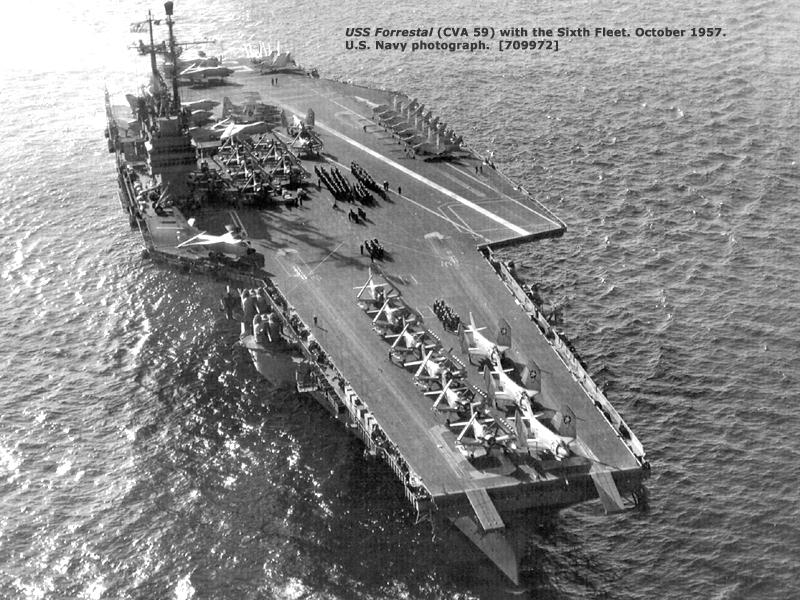
The USS Forrestal. The US no longer operates carriers in this size class.
Four Options
RAND looked at four notional designs, each with its own strengths and weaknesses in a major war (and each with a nigh-incomprehensible designation):
At the high end: a 100,000 ton nuclear carrier (CVN 8X), a slightly less expensive version of the Ford. RAND found this ship sacrificed some sortie generation capability – the ability to land aircraft, refuel and rearm them, and get them back in the air, over and over – for “only incremental reduction” in cost. By the time you’d paid to develop and debug the new design, there might be no savings over the Ford class at all.
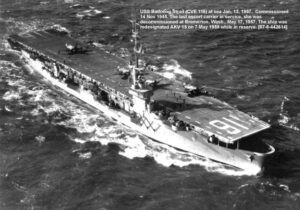
The escort carrier Badoeing Strait
At the low end: a 20,000 ton conventionally powered carrier (CV-EX), a modern version of the escort carriers of World War II. Such a small deck couldn’t operate a complete carrier air wing, only jump-jets like the F-35B, tiltrotors like the V-22 Osprey, and helicopters – and not many of those. Other capabilities like electronic warfare would have to come from larger carriers and land bases that can accommodate larger aircraft, or the Navy would have to develop new vertical take-off and landing aircraft for those roles. So the escort carrier “is not a practical variant at all,” RAND said, without major and potentially expensive changes in how the Navy operates.
More interesting are the two options in the middle:
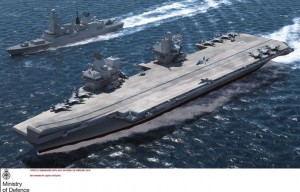
HMS Queen Elizabeth
A 70,000 ton nuclear carrier (CVN-LX), almost a third smaller than the Ford but still with a full-size flight deck able to operate the same aircraft. (There’ve been proposals for a conventional carrier in this weight class, like the British Queen Elizabeth or the former USS Forrestal, but RAND strangely didn’t study that). This ship would generate fewer sorties per day than the Ford, unsurprisingly, but RAND estimated “this is not a significant limitation for stressing warfighting scenarios.” More seriously, the 70,000-ton ship could carry less ammunition and fuel per airplane than the Ford, so it might require more frequent resupply, always awkward when under fire. Nevertheless, RAND said, it “would allow considerable savings across the ship’s service life and appears to be a viable alternative to consider for further concept exploration.” (Our italics).
A 40,000 ton conventional carrier (CV-LX), an upgraded version of the current amphibious assault ship USS America. Like the America, this ship’s deck would be small enough that it could only operate F-35Bs, V-22s, and choppers, so it would require outside support, but much less than the smaller escort carrier concept. Since this class derives from an existing design, it would be relatively “low-risk” and affordable, RAND said, and two of them could most of the work of one Ford – but not all, meaning they wouldn’t be a “viable option” to replace it without many other changes to the fleet.
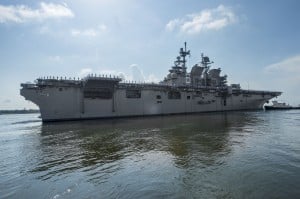
LHA-6, the USS America
When McCain’s white paper calls for smaller carriers, it specifically recommends ships in this class – but not to replace the supercarriers in the Navy’s carrier strike groups (CSGs). Instead, he wanted to build such non-nuclear light carriers to replace the aging Wasp-class big-deck amphibs in Amphibious Ready Groups (ARGs), which carry Marines. The idea was to give the Marines more airpower for more demanding missions, not to give the fleet carriers less. That crucial nuance was somehow lost along the way from McCain to the statutory language to the Navy to RAND.
“The debate will not end with this study, as it has not ended after myriad other studies that have reached similar conclusions,” retired Navy officer Bryan McGrath told me. “Smaller, limited purpose carriers have a place in the future fleet, but as an adjunct to—not a replacement for—large nuclear-powered carriers.”
Subscribe to our newsletter
Promotions, new products and sales. Directly to your inbox.
